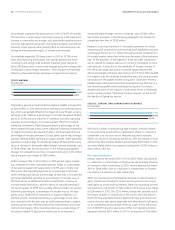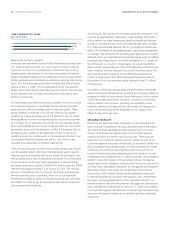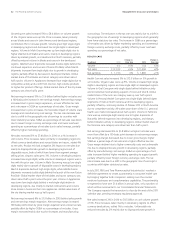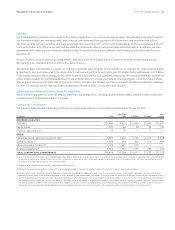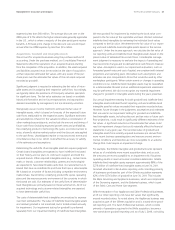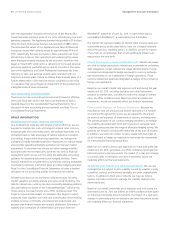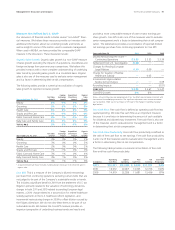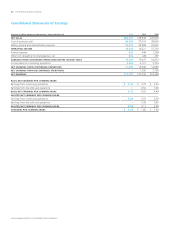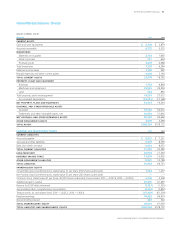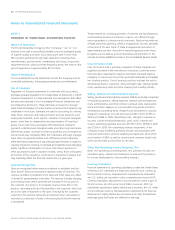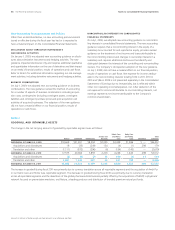Proctor and Gamble 2011 Annual Report Download - page 50
Download and view the complete annual report
Please find page 50 of the 2011 Proctor and Gamble annual report below. You can navigate through the pages in the report by either clicking on the pages listed below, or by using the keyword search tool below to find specific information within the annual report.48 The Procter & Gamble CompanyManagement’s Discussion and Analysis
SIGNIFICANT ACCOUNTING POLICIES AND ESTIMATES
In preparing our financial statements in accordance with U.S. GAAP,
there are certain accounting policies that may require a choice between
acceptable accounting methods or may require substantial judgment
or estimation in their application. These include income taxes, certain
employee benefits and acquisitions, goodwill and intangible assets.
We believe these accounting policies, and others set forth in Note
to the Consolidated Financial Statements, should be reviewed as they
are integral to understanding the results of operations and financial
condition of the Company.
The Company has discussed the selection of significant accounting
policies and the effect of estimates with the Audit Committee of the
Company’s Board of Directors.
Income Taxes
Our annual tax rate is determined based on our income, statutory tax
rates and the tax impacts of items treated differently for tax purposes
than for financial reporting purposes. Tax law requires certain items
be included in the tax return at different times than the items are
reflected in the financial statements. Some of these differences are
permanent, such as expenses that are not deductible in our tax return,
and some differences are temporary, reversing over time, such as
depreciation expense. These temporary differences create deferred tax
assets and liabilities.
Deferred tax assets generally represent the tax effect of items that
can be used as a tax deduction or credit in future years for which we
have already recorded the tax benefit in our income statement.
Deferred tax liabilities generally represent tax expense recognized in
our financial statements for which payment has been deferred, the
tax effect of expenditures for which a deduction has already been
taken in our tax return but has not yet been recognized in our financial
statements or assets recorded at fair value in business combinations
for which there was no corresponding tax basis adjustment.
Inherent in determining our annual tax rate are judgments regarding
business plans, planning opportunities and expectations about future
outcomes. Realization of certain deferred tax assets is dependent upon
generating sufficient taxable income in the appropriate jurisdiction prior
to the expiration of the carryforward periods. Although realization is
not assured, management believes it is more likely than not that our
deferred tax assets, net of valuation allowances, will be realized.
We operate in multiple jurisdictions with complex tax policy and
regulatory environments. In certain of these jurisdictions, we may
take tax positions that management believes are supportable, but are
potentially subject to successful challenge by the applicable taxing
authority. These interpretational differences with the respective
governmental taxing authorities can be impacted by the local economic
and fiscal environment. We evaluate our tax positions and establish
liabilities in accordance with the applicable accounting guidance on
uncertainty in income taxes. We review these tax uncertainties in light
of changing facts and circumstances, such as the progress of tax audits,
and adjust them accordingly. We have a number of audits in process
in various jurisdictions. Although the resolution of these tax positions
is uncertain, based on currently available information, we believe that
the ultimate outcomes will not have a material adverse effect on our
financial position, results of operations or cash flows.
Because there are a number of estimates and assumptions inherent
incalculating the various components of our tax provision, certain
changes or future events such as changes in tax legislation, geographic
mix of earnings, completion of tax audits or earnings repatriation plans
could have an impact on those estimates and our effective tax rate.
Employee Benefits
We sponsor various post-employment benefits throughout the world.
These include pension plans, both defined contribution plans and
defined benefit plans, and other post-employment benefit (OPEB)
plans, consisting primarily of health care and life insurance for retirees.
For accounting purposes, the defined benefit pension and OPEB plans
require assumptions to estimate the projected and accumulated
benefit obligations, including the following variables: discount rate;
expected salary increases; certain employee-related factors, such as
turnover, retirement age and mortality; expected return on assets and
health care cost trend rates. These and other assumptions affect the
annual expense and obligations recognized for the underlying plans.
Our assumptions reflect our historical experiences and management’s
best judgment regarding future expectations. As permitted by U.S.
GAAP, the net amount by which actual results differ from our
assumptions is deferred. If this net deferred amount exceeds 10% of
the greater of plan assets or liabilities, a portion of the deferred amount
is included in expense for the following year. The cost or benefit of
plan changes, such as increasing or decreasing benefits for prior
employee service (prior service cost), is deferred and included in
expense on a straight-line basis over the average remaining service
period of the employees expected to receive benefits.
The expected return on plan assets assumption impacts our defined
benefit expense, since many of our defined benefit pension plans and
our primary OPEB plan are funded. The process for setting the expected
rates of return is described in Note 8to the Consolidated Financial
Statements. For 2011, the average return on assets assumptions for
pension plan assets and OPEB assets were7.0% and 9.2%, respectively.
A change in the rate of return of 50 basis points for both pension
and OPEB assets would impact annual after-tax benefit expense by
less than $50 million.
Since pension and OPEB liabilities are measured on a discounted basis,
the discount rate impacts our plan obligations and expenses. Discount
rates used for our U.S. defined benefit pension and OPEB plans are
based on a yield curve constructed from a portfolio of high quality bonds
for which the timing and amount of cash outflows approximate the
estimated payouts of the plan. For our international plans, the discount
rates are set by benchmarking against investment grade corporate
bonds rated AA or better. The average discount rate on the defined
benefit pension plans of 5.3% represents a weighted average of local
rates in countries where such plans exist. A 50 basis point change in
the discount rate would impact annual after-tax defined benefit pension


